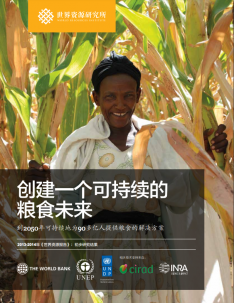Creating a Sustainable Food Future: Interim Findings
A menu of solutions to sustainably feed more than 9 billion people by 2050

The world urgently needs to improve the way it produces and consumes food. In the coming decades, agriculture—which employs two billion people today—must provide enough food for a growing population and be an engine of inclusive economic and social development. However, the environmental impacts of agriculture are large and growing, creating risks for future food production.
Today, we use roughly one-half of the planet’s vegetated land to grow food. The amount of land used for agriculture has grown by more than 10 million hectares per year since the 1960s, and expanding croplands and pasture lands are placing increasing pressure on tropical forests. Agriculture now accounts for nearly one-quarter of global greenhouse gas emissions and 70 percent of all freshwater use. As the human population continues to grow, with billions joining the global middle class in the coming decades, these trends are set to intensify. By 2050, agriculture alone could consume 70 percent of the total allowable “budget” of greenhouse gas emissions consistent with limiting global warming to two degrees.
This is the great challenge: To adequately feed more than nine billion people by 2050, the world must close a 70 percent gap between the amount of food produced today and that needed by mid-century. At the same time, to advance sustainable development, we must close this “food gap” in ways that enhance the livelihoods of poor farmers and reduce agriculture’s impact on the environment. Failure to address the environmental impacts would hamper food production in coming decades—through land degradation, water shortages, and adverse effects from climate change.
This report presents the interim findings of the World Resources Report 2013–2014: Creating a Sustainable Food Future, a collaboration of the World Resources Institute, the United Nations Development Programme, the United Nations Environment Programme, and the World Bank. The report analyzes the challenge and identifies the most promising technical options from a comprehensive “menu” of practical, scalable strategies that could close the food gap, while simultaneously reducing pressure on the environment and providing valuable economic and social benefits. The final Creating a Sustainable Food Future report will quantify each menu item’s potential contribution to closing the food gap and to mitigating greenhouse gas emissions and other environmental impacts. It will also identify the practices, policies, and incentives necessary to implement the solutions at the necessary scale.